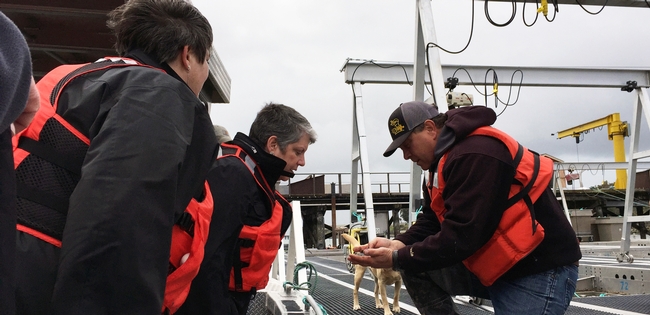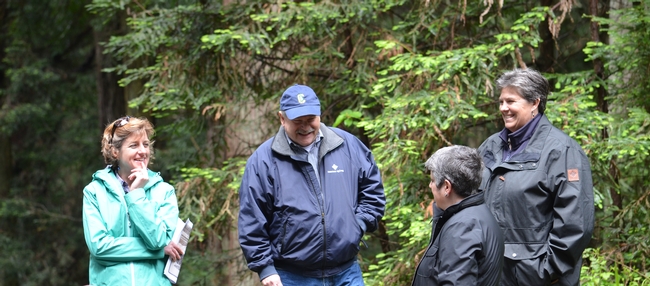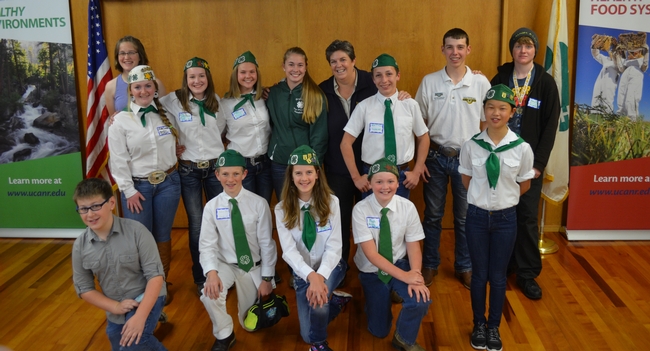UC president sees UC research in the real world
Although UC's northernmost campus is UC Davis, the region is served by UC Cooperative Extension. The university opened its first Cooperative Extension office in Eureka in 1913, but April 27 marked the first official visit to Humboldt County by a UC president.
“I hope to show the president how local residents benefit from UC Cooperative Extension and to give President Napolitano and Vice President Humiston ideas on how the university may get more involved in solving local challenges,” said Yana Valachovic, UC Cooperative Extension director and forest advisor for Humboldt and Del Norte counties, who organized the tour.

Accompanied by Glenda Humiston, UC vice president for Agriculture and Natural Resources, Napolitano's day began at the Potawot Health Village in Arcata, where United Indian Health Services (UIHS) has a clinic and gardens of more than 35 varieties of fruits, vegetables, and medicinal plants that serve 15,000 people in Del Norte and Humboldt counties.
Because the rate of diabetes among Native Americans is twice that of non-Hispanic whites, UIHS provides an integrated nutrition education program. The work of UC Cooperative Extension advisors Deborah Giraud and Dorina Espinoza and Jessica Conde Rebholtz, nutrition educator for the Expanded Food and Nutrition Education Program (EFNEP), complements UIHS's efforts for low-income community members.
“In EFNEP, we measure behavior changes over an eight-week program and we have seen positive changes in how people manage their resources. So, we can promote healthy eating within a budget,” said Espinoza. “But unless we have an environment that supports the very changes we're promoting, the habits are difficult to sustain.”
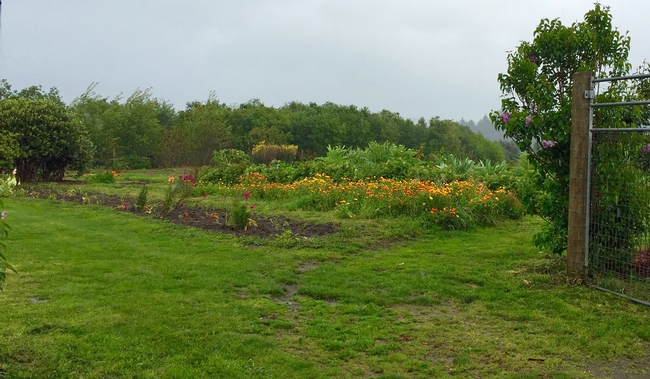
Rebholtz observed that collaborating agencies offer healthier options for their EFNEP clients and have begun replacing sugary drinks and goldfish crackers with water, fruit and vegetables as children's snacks.
“UC's statewide Nutrition Policy Institute works closely with our county-based Cooperative Extension teams and is doing the research on the effectiveness of these activities so we get this feedback loop that improves the programs,” Humiston noted.
Ensuring food security, health and sustainability are among the goals of UC's Global Food Initiative.

On the boat, Coast Seafoods Company manager Greg Dale shucked an oyster fresh from the bay. The former Arizona governor ate the oyster on the half shell.
“It doesn't get any fresher than this,” Dale said.
Dale explained how his company works with UC Cooperative Extension, UC Sea Grant and other businesses and organizations to maintain the water quality in the bay. “We all need excellent water quality for economic activity,” he said.
Dina Moore, who is married to a sixth-generation rancher in Kneeland and serves on the UC President's Advisory Commission for agriculture, told Napolitano she appreciates the expertise that Cooperative Extension brings from campus as much as the research the advisors provide locally to manage natural resources. “I think the university helps us embrace the reality of being environmentally forward-thinking,” Moore said.
Climate change is one of the challenges that UC is helping Humboldt County businesses address.
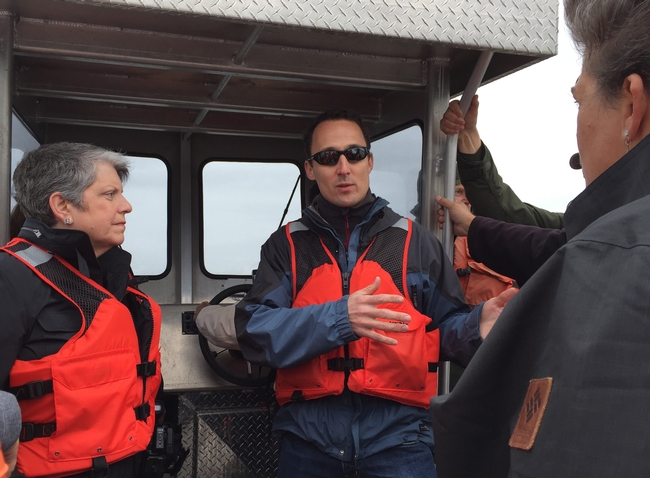
“Lower pH and carbonate saturation makes it more difficult for shellfish to acquire and assimilate carbonate from seawater to make their shells. Larval shellfish are especially vulnerable because of their small size and the fact that their shells are composed of aragonite, a more sensitive form of calcium carbonate,” Dale said. “It can affect their energy budget and survival.”
With the support of university researchers, hatcheries are monitoring the chemistry of seawater with an instrument called a Burkolator. “When the pH, and more importantly carbonate saturation, of seawater decrease to the point that it is harmful to larvae – which can occur during upwelling – hatchery managers can shut off intake pumps or add chemicals to buffer the water,” Tyburczy explained.
“We need someone like Joe to analyze the data and tell us what it means,” said Dale.
Forests provide economic and ecological benefits
After the boat ride, Napolitano and Humiston took a walk in the City of Arcata Community Forest, the largest community-owned forest in California. Mark Andre, City of Arcata environmental services director, described how the city works with UC to manage the 2,300 acres of redwoods for timber, wildlife, water quality and to sequester carbon for future generations, while simultaneously providing high-quality recreational opportunities for city residents.
“UC Cooperative Extension is important to us,” Andre said. “Community-based forestry integrates ecological, social and economic strategies. To honor the ecological emphasis we need science to inform our management decisions.

“This year we were able to coordinate several partners and bring $2.6 million dollars in conservation funding to help landowners restore their oak woodlands,” Valachovic said. “We provide a science, policy, research and educational hub for the region.”
When asked what she found most interesting about the bay and forest visits, Napolitano replied, “There's a relationship from the water to the land to the mountain and forest and there's a lot of science and biology that links those things in terms of how we think about them.”
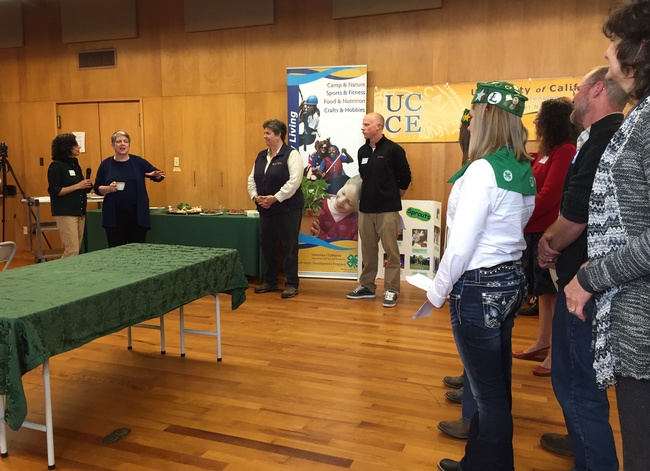
In the afternoon, UC 4-H Youth Development Program members and volunteers described for Napolitano and Humiston their projects, which ranged from raising calves to teaching safety in shooting sports to quickly solving a Rubik's cube to making videos and organizing a fashion week.
“4-H helps us build life skills,” said Molly Crandall, president of Arcata Bottom, California's oldest 4-H club, founded in 1913.
Napolitano lauded the 4-H members and volunteers for their accomplishments, and told them, “Know that through UC, and UC Extension and our Ag and Natural Resources Division, we intend to not only continue supporting 4-H, but doing evermore with 4-H because I think it's a great, great organization.”
At the end of the day, the president thanked all of the tour participants for enlightening her on what UC is doing in Humboldt County. “What I've been listening for today, and looking forward to hearing more about, is what more canthe university do,” Napolitano said. “I truly believe this is a great area of the state of California.”
Napolitano and Humiston joined in the 4-H pledge
Related links:
A UC president to visit Humboldt County for first time ever by Marc Vartabedian, the Eureka Times-Standard
Garden Tours with Homeland Security by Grant Scott-Goforth, North Coast Journal
University of California president visits Humboldt County by Taylor Torregano, KAEF-TV
UC Cooperative Extension in Humboldt County
